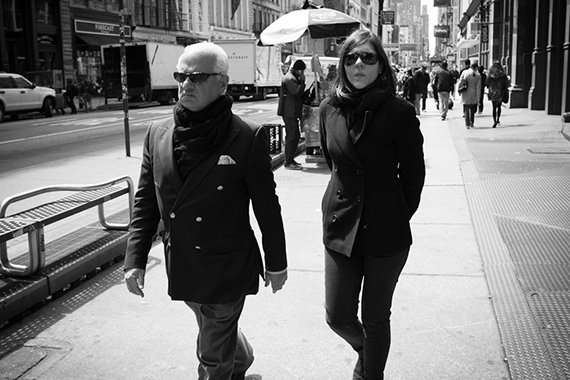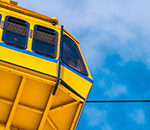1. Seek Out Emotion
This is an easy point to make—photographs are better when they show people’s emotions. However, it’s much easier said than done. It is difficult to capture emotions in the wild, but they are there if you look for them. Be careful about getting overly distracted by a person’s clothing or look and instead pay attention to people’s faces and postures and capture them when they are expressive—both the strong and subtle expressions.

Protégé, SoHo
2. Tell a Story
This is related to photojournalism in a way, but think about a story and capture it. Gentrification in my neighborhood is a big and often talked about issue so when I’m out I pay attention to scenes and situations that portray it.

Gentrification, East Village
The photo above is of a beautiful, old, faded black and red trimmed building that is in the midst of a complete renovation, now half painted in sterile white paint. Black to white – it’s so simple yet so poignant.
Another example is the shot below of a trendy crowd waiting outside a popular brunch spot. There are a million and a half ways to visually show the effects of gentrification.

Brunch Fur Coat, East Village
3. Create a Strong Design
When all else fails, just create a gorgeous design. Pay attention to colored walls, lines and columns, advertisements, and textures. Pay attention to strong contrasts, especially with colors. I know some of these elements may seem new and ordinary, but as many of them age they will have significant cultural value. Seek out everyday things that are beautiful and create some beautiful scenes.
Always pay attention to the lines and corners in your photos and also think about the way that a viewer’s eyes might enter and follow through the scene. This is important to the balance of your images.

72 Walker Street.

Flashdancers and Blue Wall, Lafayette Street
4. Photograph the Unseen
Often we are attracted to the colorful, fashionable, extroverted people, or on the other end of the spectrum, to the down and out, the homeless, or the ‘dark side’. These extremes account for such a small sliver of actual life and the reality is that a majority of the world resides between them. Capture the stories in the middle.

Construction Worker, Canal Street
And if you ever interview people keep this in mind. The most average looking people often have the most interesting stories to tell.
5. Create Intrigue and Ambiguity
Find ways to make people curious about the meaning of your images. Make people question what is going on. Ambiguity done correctly is a special thing. It creates a work that someone can put on their wall and continue to think about over time with the meaning changing constantly depending on what the viewer chooses to believe at any moment.

A Tree Grows, Chase Bank.
This is similar to capturing a story and I find it to be the hardest to do. The goal is to capture an image that has a point of view or makes a statement. It us the type of image that you could write a lot about.

Varietions of The Same.

New Arrivals
Above, you’ll find a couple of images that are critiques on modern fashion trends and consumption. When shooting street photography, remember, the best shots will not always be glaringly obvious. You must learn how to open your mind and use your eye in way that opens you up to seeing the bigger picture.
About the Author:
James Maher is the author of Essentials of Street Photography, which covers everything about the genre even down to specific post processing techniques that can bring the best out of street scenes.
Like This Article?
Don't Miss The Next One!
Join over 100,000 photographers of all experience levels who receive our free photography tips and articles to stay current:





This article and the photographs are rubbish, as nearly every commentator has said. So as it was originally published so long ago (see dates of comments) why has it been published again?
A building is not a subject for Street Photography.
Mary Kay – The image with the garbage shows the juxtaposition of high fashion in the midst of the reality of life – – “beauty is in the eye of the beholder.” The objective of street photography is to find beauty, art and/or a story in the images all around us that we walk pass and take for granted on a daily basis. Remember, the idea of looking at a photograph is to take in the image in its entirety. As artists, our eye should always be expanding and looking deeper.
I just don’t understand street photography. There is just nothing in these photos that I find interesting. Garbage? Graffitti? Am I alone in this?
Street photography is an extremely interesting genre – if done right. Unfortunately, the photos shown as examples are not the best representation of what it should be like. In fact, almost all of them look like accidental shutter clicks, so you are not alone. They do suck.
Good article. Street photography is definitely one of my favourite things to be out shooting. I like your section about creating intrigue.
I would interested on your take on street photography etiquette—taking photos of people without their permission etc.